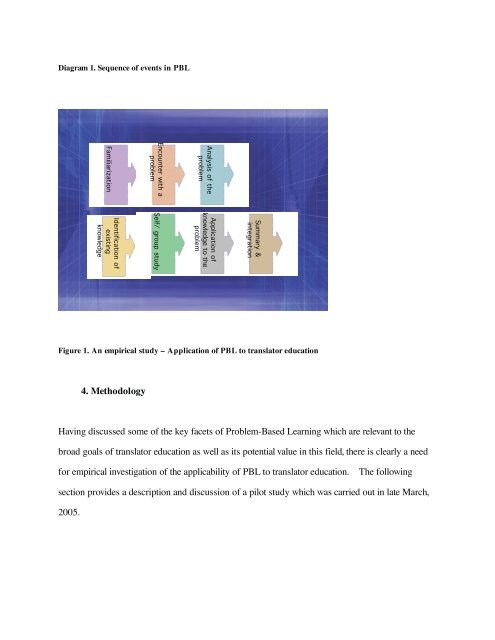PBL as a New Pedagogical Approach for Translator Education
PBL as a New Pedagogical Approach for Translator Education PBL as a New Pedagogical Approach for Translator Education
Tamblyn (1980), Forgarty (1997), and Woods (1994) point out. This can be considered as the central feature of this approach, and the “problem” needs to be one that is “relatively challenging” (Forgarty 1997 and Boud 1987) at the learners’ current level. In most of the cases described in previous studies, there tends to be one major problem which is underpinned by a number of sub-problems. The second characteristic of the Problem-Based Learning approach is the authenticity of the problem at hand, as the aim of this approach is, of course, to provide learners with the opportunity to solve a problem in a real-life context. Increased learner autonomy is the third feature of the approach. As Schwartz, Mennin and Webb (2001) noted, learners are likely to take active steps that are required for solving the problem. This results in, as the last characteristic, a teacher who no longer acts as an instructor who provides an answer, but as a facilitator whose role is to provide appropriate scaffolding for the learners, as Boud (1987) points out. Having clarified the major characteristics of PBL, it is then necessary to understand the sequence of learning in this approach. While there are some minor variations the elements of this sequence as it is described in the research literature, including Kolb (1984), Lewin (1951) and Barrows & Tanblyn (1980), the sequence presented in the Diagram 1 appears to be common among them. As indicated in the diagram, the focus lies on the analysis of the problem which then requires learners to explicate their existing knowledge which is relevant to solving the problem and knowledge with which they have not been equipped. These actions are then followed by the learners’ implementation of search for unknown knowledge through both individual and group study towards the acquisition of non-existing knowledge and the integration of their existing and newly acquired knowledge towards a solution. It should also be noted that one cycle of this sequence does not necessarily mean the end of the entire action but it is possible that this cycle of action is repeated in the same way with some improvements, if learners find the refinement and elaboration necessary.
Diagram 1. Sequence of events in PBL Familiarization Identification of existing knowledge Encounter with a problem Self/ group study Analysis of the problem Application of knowledge to the problem Summary & integration Figure 1. An empirical study – Application of PBL to translator education 4. Methodology Having discussed some of the key facets of Problem-Based Learning which are relevant to the broad goals of translator education as well as its potential value in this field, there is clearly a need for empirical investigation of the applicability of PBL to translator education. The following section provides a description and discussion of a pilot study which was carried out in late March, 2005.
- Page 1 and 2: PBL as a New Pedagogical Approach f
- Page 3 and 4: translator) provides a mere “answ
- Page 5 and 6: knowledge of their specialised area
- Page 7: novice-expert differences and their
- Page 11 and 12: solving the given problem both as a
- Page 13 and 14: The final stage where the subjects
- Page 15 and 16: of its direct linkage with their le
- Page 17 and 18: which may not be appropriate in all
- Page 19 and 20: APPENDIX 1 KND chart (adapted from
- Page 21: B. Please comment freely on the fol
Diagram 1. Sequence of events in <strong>PBL</strong><br />
Familiarization<br />
Identification of<br />
existing<br />
knowledge<br />
Encounter with a<br />
problem<br />
Self/ group study<br />
Analysis of the<br />
problem<br />
Application of<br />
knowledge to the<br />
problem<br />
Summary &<br />
integration<br />
Figure 1. An empirical study – Application of <strong>PBL</strong> to translator education<br />
4. Methodology<br />
Having discussed some of the key facets of Problem-B<strong>as</strong>ed Learning which are relevant to the<br />
broad goals of translator education <strong>as</strong> well <strong>as</strong> its potential value in this field, there is clearly a need<br />
<strong>for</strong> empirical investigation of the applicability of <strong>PBL</strong> to translator education. The following<br />
section provides a description and discussion of a pilot study which w<strong>as</strong> carried out in late March,<br />
2005.



